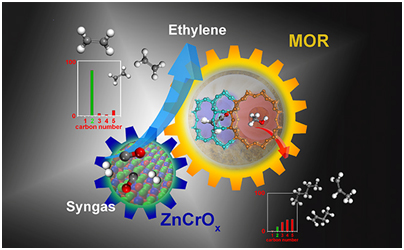Recently, Prof. Pan and Prof. Bao et al. have made progress in selective syngas conversion to ethylene via OX-ZEO process. Such results are published in Angewandte Chemie-International Edition(2018, 57(17), 4692-4696) as "Hot Paper".

Controlled C-C coupling is always the key challenge in C1 chemistry especially for efficient utilization of syngas from coal, natural gas and biomass. This work builds upon the OX-ZEO concept reported previously by the team that separating the C-O activation as well as C-C coupling onto metal oxides and zeolites during syngas conversion. In this way, high selective of mixed light olefins (C2=-C4=)(Science 351 (2016) 1065-1068; ACS Catalysis 7 (2017) 2800-2804) and aromatics (Chemical Communication 53 (2017) 11146-11149)can be achieved. Herein, the research team steered the product selectivity towards ethylene by employing ZnCrOx-mordenite (MOR) bifunctional catalysts. The selectivity of ethylene alone reaches as high as 73% among other hydrocarbons at a 26% CO conversion. This selectivity is significantly higher than those obtained in any other direct syngas conversion or the multistep process methanol-to-olefin conversion. This highly selective pathway is realized over the catalytic sites within the 8-membered ring (8MR) side pockets of MOR via a ketene intermediate rather than methanol in the 8MR or 12MR channels. This study provides substantive evidence for a new type of syngas chemistry with ketene as the key reaction intermediate and enables extraordinary ethylene selectivity within the OX-ZEO catalyst framework. Moreover, this work again demonstrated the OX-ZEO concept as a new platform for better utilizing coal via syngas.